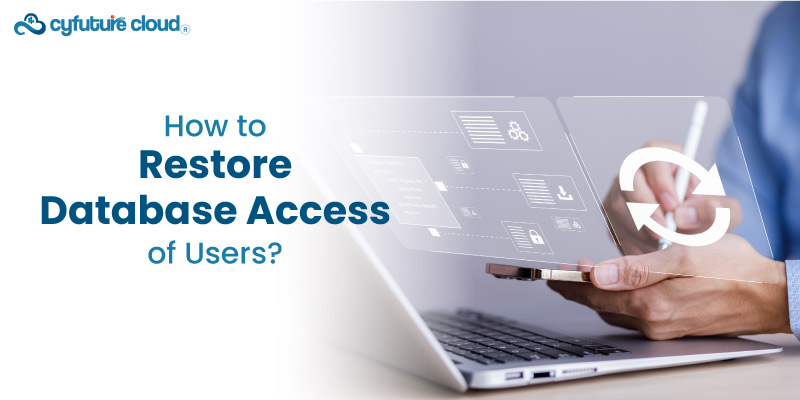 Server
Colocation
Server
Colocation
 CDN
Network
CDN
Network
 Linux Cloud
Hosting
Linux Cloud
Hosting
 VMware Public
Cloud
VMware Public
Cloud
 Multi-Cloud
Hosting
Multi-Cloud
Hosting
 Cloud
Server Hosting
Cloud
Server Hosting
 Kubernetes
Kubernetes
 API Gateway
API Gateway


Assume you work as a librarian, and one day, you discover that the entrance to your library's enormous collection of books has been abruptly locked, leaving a queue of anxious readers outside. The situation is not too dissimilar from what occurs when users cannot access a database.
Many apps are built around databases, which house anything from user data to vital corporate information. Denial of access can cause significant productivity loss, disrupt processes, and irritate users. Thankfully, there are ways to regain database access, just as there are keys to open doors.
This post will walk you through the straightforward and thorough process of giving users their database access again.
Understanding why people lose access to a database is essential before moving on to remedies. Numerous elements may be involved in this problem:
- Permission Changes: Access may be restricted by unintentional or deliberate changes made to user permissions.
- Database Upgrades or Migrations: If database software is updated or a new server is moved, it may occasionally result in access problems if not handled properly.
- Problems with Passwords: Frequently, the cause needs to be forgotten or passwords expire.
- User profile corruption: Access may be blocked by database corruption or mistakes in user profiles.
Finding the proper answer starts with determining the underlying reason.
First, ascertain the extent of the issue. Does it impact a specific subset of users or all of them?
Is it the case that users can only access particular bits of the database or the entire thing?
The answers to these queries can assist in identifying the problem, be it localized data corruption, a worldwide authorization issue, or something else entirely.
User's permissions determine what they can and cannot do within a database.
The first place to look if users have lost access is their permissions:
Examine user permissions and roles: Ensure the proper responsibilities are assigned to each user. There are many degrees of access for roles such as Administrator, Read-Only, and Data Entry.
If needed, restore permissions: If permissions have been changed, reset them following the user's job requirements or your organization's policy.
Resetting user passwords can help restore access if the problem is with forgotten, expired, or restricted accounts:
Employ administrative instruments: Most database management systems (DBMS), such as Microsoft SQL Server, PostgreSQL, and MySQL, provide administrators with the ability to change user passwords.
Talk safely: Ensure the communication channel is secure when giving users new passwords to avoid eavesdropping.
Sometimes, the problem isn't with the user account but with the connection to the database itself:
Verify network settings: Ensure the database server is reachable over the network. Check if any firewalls or network policies are blocking the connection.
Examine database server status: Ensure the service runs and listens on the expected port.
Corrupted data can prevent users from accessing the database. If you suspect corruption:
Use built-in repair tools: Most DBMSs have tools to check and repair corrupted tables or databases.
Restore from backup: If corruption is extensive, restoring the affected data from a backup might be necessary.
If the access issue coincided with a database migration or upgrade:
Review migration logs: These logs can highlight errors or issues encountered during the process that may have affected user access.
Double-check compatibility: Ensure all user applications and tools are compatible with the new database version or environment.
Sometimes, the issue might be spare, user error, or misunderstanding each ordaining:
Offer guidance or training sessions on correctly accessing and using the database.
Create documentation: Make sure there are clear, accessible instructions for following troubleshooting steps.
It's always preferable to prevent than to cure. The following recommendations should help avoid access database problems in the future:
Recurring backups: Maintaining a regular database backup guarantees that you can promptly recover access and data in the event of an issue.
Regular audits: Reviewing database health and user permissions regularly can help ensure problems before they become serious.
Revise the policies: To reduce human error and security concerns, implement procedures for data handling, access control, and password management.
Spend money on training: Reducing mistakes that result in access concerns may be achieved by ensuring administrators and users are adequately educated in utilizing and maintaining the database.
Like solving a puzzle or restoring, ensuring the database service runs, listening to details, and maybe a little detective work. You may restore user access to the database by carefully identifying the problem, verifying connection, examining permissions, and resolving any possible data damage.
Recall that the secret to preserving seamless database access is not only knowing how to solve problems as they occur and how to prevent them via meticulous planning, consistent upkeep, and continuous training. Using these procedures, keep your digital library's doors open and available to everybody who needs it.

Let’s talk about the future, and make it happen!
By continuing to use and navigate this website, you are agreeing to the use of cookies.
Find out more


